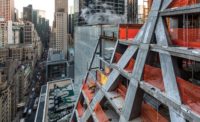Related Article:
P-310 Dry Dock 1 Super Flood Basin
Back to:
25 Top Newsmakers
On the morning of June 20, 2021, Andrew Hallett faced a career-defining moment. A senior project manager at Pittsfield, Maine-based Cianbro, Hallett helped lead a team that built a 5,338-ton concrete precast structure that would serve as the entrance of a new navigation lock basin at Portsmouth Naval Shipyard. The massive, one-of-a-kind structure, which had been cast entirely on a floating barge for more than a year at Cianbro’s Ricker’s Wharf facility in Portland, Maine, set off that day down the Fore River and into Casco Bay, en route to the Navy shipyard. The high-profile project not only had the attention of the client, NAVFAC, it also had attracted some curious onlookers.
“There was a quite a gathering of people following the tug and the barge, all gathered up to watch it come around the corner,” he recalls. “There was a lot of nervousness as it was coming up the river.” Precisely timed with the tidal charts, the barge bore the structure into place during high tide June 21, where it was secured to strand jacks. As the tide went out, the barge dropped below the suspended structure and the strand jacks held it as the barge left. The real moment of truth came as the structure was lowered into the basin, where it had to set down precisely on four drilled shafts underwater. With a tolerance of only 1⁄8-in. , crews were able to set the structure in its final resting spot. “It was an extremely detailed plan,” he recalls. “Everybody knew what they needed to do in all regards—from the tugboat operators to the craft guys out on site—and it went off like clockwork.”
It was the culmination of an effort by Cianbro to deliver critical infrastructure on a tight timeline. NAVFAC and designer Stantec determined early on that to meet its deadlines, the structure would need to be cast offsite. When Cianbro won the design-bid-build contract in December 2019, it put forward an even more ambitious plan to build it entirely on a barge in one piece and place it onsite in one shot.
“We put out an idea that, on its face, is pretty bizarre, especially for a DOD job,” recalls Bob Bittner of Bittner-Shen Consulting Engineers, now Cowi, which served as a consulting engineer on the project under Cianbro. “And Andrew’s team was able to work out the details to a level of precision that I previously didn’t think was possible.”
Although it was a design-bid-build job, the innovative nature of the project required extensive collaboration. “The first time Andrew rolled out the concept, we had a good crowd gathered,” says Paul Harrington, vice president at Stantec. “From there we all refined and optimized the concept. It was a very iterative process.”
Once the plan was in place, crews cast the 110-ft-wide, 67-ft-long and 60-ft-tall structure on a 72-ft-wide, 340-ft-long barge. Due to how the structure had to be oriented for installation, crews had to cast the widest ends over the water. They carried out the work for more than a year, navigating tides daily as well as a full Maine winter. Crews had to regularly ballast the barge as loads shifted during pours.
Hallett’s attention to detail was evident from his first projects as an intern, says Andi Vigue, Cianbro president and CEO. In the 17 years since, Hallett has grown to be a natural leader. “He’s not a pound-the-table type of leader,” Vigue says. “He’s a person who’s a good listener, he understands how to motivate people and he knows how to take care of people. … People like Andrew are the future of this company.” Hallett says one of his biggest takeaways from the project is the value of mentoring and encouraging the next generation of Cianbro employees. “Since the conclusion of that job, multiple people have taken higher roles in the company due to what they learned and experienced,” he says. “That’s great to see.”



